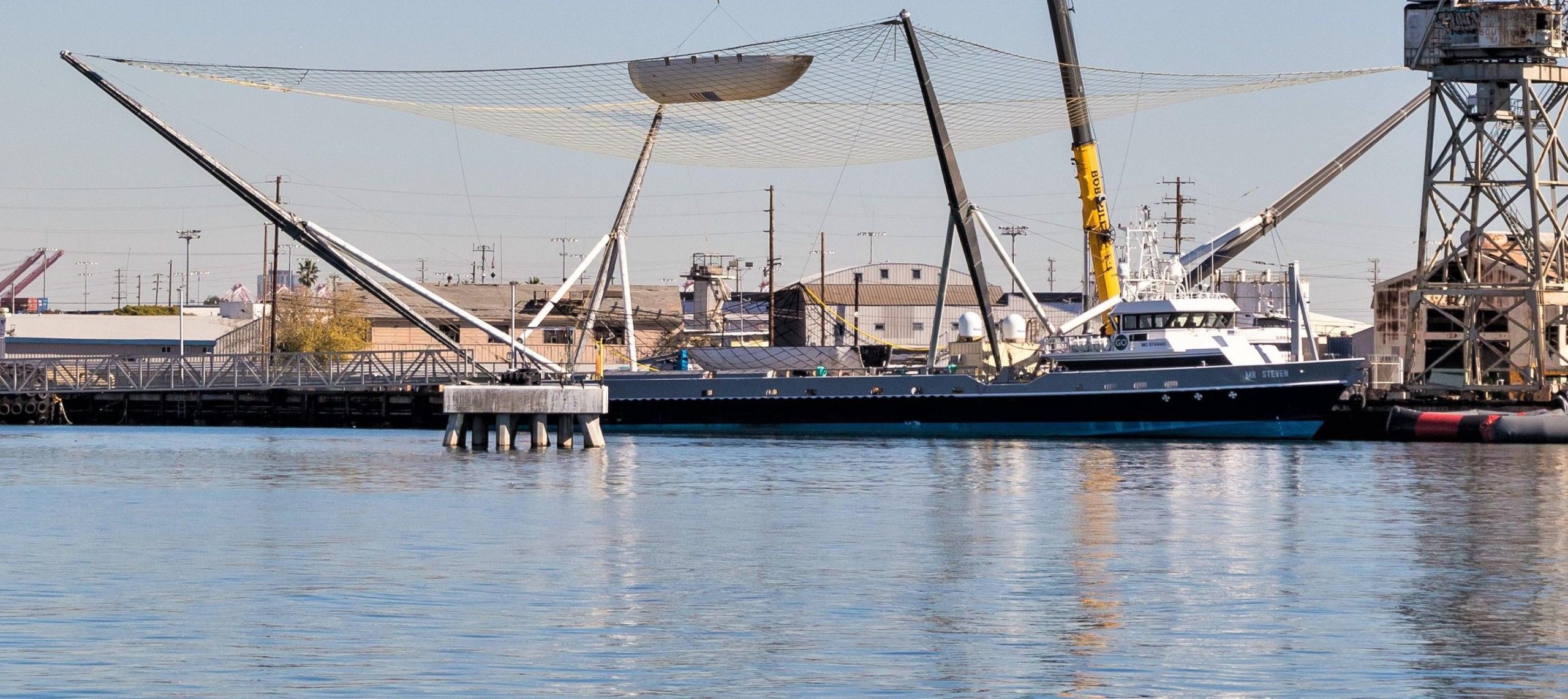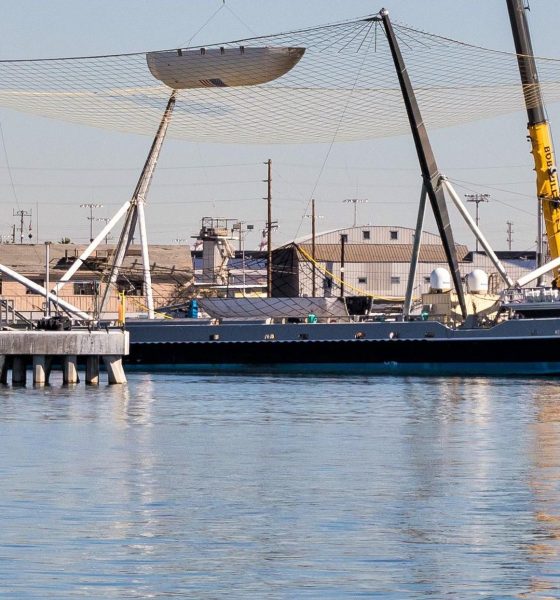

News
SpaceX isn’t giving up on catching rocket fairings, boat spotted with new net
SpaceX fairing recovery vessel Mr. Steven was spotted in Port of San Pedro on January 22nd performing tests with two fairings in its net, hinting at the challenging logistics of safely recovering both Falcon 9 fairing halves with one ship.
Although SpaceX engineers and technicians have yet to catch a parasailing Falcon 9 fairing (let alone two) after an actual operational launch, a series of controlled fairing drop tests – using a barge and a helicopter – have brought Mr. Steven agonizingly close to success, evidenced by an official video published by SpaceX earlier this month.
Two fairing halves, each in a separate net aboard Mr Steven this morning. #spacex pic.twitter.com/beYSFQwcYr
— Pauline Acalin (@w00ki33) January 23, 2019
Teslarati photographer Pauline Acalin managed to make it to Berth 240 in time to capture one section of SpaceX’s fairing recovery testing, in which Mr. Steven was loaded with two fairings, one on the large main net (the passive half) and one (the active half) atop a much smaller net slack on the vessel’s deck. By asymmetrically actuating each net’s separate electric motors, recovery technicians appear to be able to control fairing half orientation and shift their position in the net. It’s unclear how exactly Mr. Steven’s main (top) and secondary (bottom) nets are meant to interface insofar as it does not appear physically possible for a fairing half in the top net to make its way to the bottom net without the intervention of dockside cranes.
Perhaps more importantly, local photographer Jack Beyer was able to observe additional activities just prior to Pauline’s arrival, capturing what looked like a weighted parachute drop test onto either Mr. Steven’s net or the concrete docks beside the vessel.
So far they’ve placed one fairing half in the top net with another in the bottom, and done at least one drop test of a weight with a parachute. ? pic.twitter.com/MkWb9l9lqz
— Jack Beyer (@thejackbeyer) January 22, 2019
The goal of that parachute/weight drop test is entirely opaque. Regardless, Tuesday’s tests do seem to indicate that SpaceX is thinking about recovering both post-launch Falcon fairing halves with a single Mr. Steven, a capability upgrade that would make the incomplete challenge of catching fairings even more difficult. Assuming both fairing halves deploy their parafoils at roughly the same time, it might be possible for the autonomous parafoils to modify trajectories in such a way that a gap of seconds or even minutes could be created between both planned splashdowns, offering Mr. Steven a minute or two to free its net of the first captured half before gently catching the second.
Despite the fact that SpaceX has not yet had operational success in the ~12 months recovery engineers and technicians have been working with Mr. Steven, tests like those performed on Tuesday have continued to reliably occur. If anything, the fact that experiments with dual-fairing recovery operations are still on the table is an encouraging indication that fairing recovery and reuse – particularly with Mr. Steven in the loop – are still a priority at SpaceX, while also suggesting that the company’s engineers and technicians are extremely confident that repeatable success is just a matter of refinement.

This should not come as a much of a surprise given that Falcon 9 began propulsive soft landing attempts in September 2013, 27 months before the company’s first successful Falcon 9 booster recovery. Nevertheless, SpaceX attempted its first actual landing aboard a drone ship in January 2015, separating the first attempt from the first successful landing by just less than 12 months. Fairing recovery is clearly an entirely different beast but the gist of this analogy remains true regardless – SpaceX’s brilliant engineers and technicians are unlikely to give up until a given problem is solved or their efforts are redirected elsewhere as company priorities shift.
Recent fairing recovery test with Mr. Steven. So close! pic.twitter.com/DFSCfBnM0Y
— SpaceX (@SpaceX) January 8, 2019
Berth 240’s uncertain future
In the meantime, SpaceX may soon have to move Mr. Steven’s Port of San Pedro operations elsewhere according to a report from the LA Times that the company plans to “terminate [its] Terminal Island lease agreement.” SpaceX was unable to offer further insight beyond a statement provided about the future of BFR’s manufacturing, initially planned to occur at a dedicated factory that would have been built at Berth 240, which has also acted as Mr. Steven’s home for the last eight months.
Given the lack of official insight into the proceedings, it’s ambiguous if the terminated lease will be modified to allow for Mr. Steven to continue operating out of Berth 240. Prior to moving to Berth 240, SpaceX stationed Mr. Steven at Berth 52, home of drone ship Just Read The Instructions (JRTI) and support vessel NRC Quest. Space is already tight at that site, however, making it a suboptimal replacement for Berth 240.
While I feel crushed about #SpaceX pulling the #SuperHeavy out of the @PortofLA, I feel confident that other innovators will see the huge value they get in San Pedro. (1/2)
— Joe Buscaino (@JoeBuscaino) January 16, 2019
SpaceX signed its Berth 240 lease near the end of March 2018 and would have reached the first anniversary of its prospective BFR factory around two months from now. For now, only SpaceX seems to know where Mr. Steven’s operations and the first BFR (Starship/Super Heavy) production will ultimately be located.

News
Tesla FSD fleet is nearing 7 billion total miles, including 2.5 billion city miles
As can be seen on Tesla’s official FSD webpage, vehicles equipped with the system have now navigated over 6.99 billion miles.

Tesla’s Full Self-Driving (Supervised) fleet is closing in on almost 7 billion total miles driven, as per data posted by the company on its official FSD webpage.
These figures hint at the massive scale of data fueling Tesla’s rapid FSD improvements, which have been quite notable as of late.
FSD mileage milestones
As can be seen on Tesla’s official FSD webpage, vehicles equipped with the system have now navigated over 6.99 billion miles. Tesla owner and avid FSD tester Whole Mars Catalog also shared a screenshot indicating that from the nearly 7 billion miles traveled by the FSD fleet, more than 2.5 billion miles were driven inside cities.
City miles are particularly valuable for complex urban scenarios like unprotected turns, pedestrian interactions, and traffic lights. This is also the difference-maker for FSD, as only complex solutions, such as Waymo’s self-driving taxis, operate similarly on inner-city streets. And even then, incidents such as the San Francisco blackouts have proven challenging for sensor-rich vehicles like Waymos.
Tesla’s data edge
Tesla has a number of advantages in the autonomous vehicle sector, one of which is the size of its fleet and the number of vehicles training FSD on real-world roads. Tesla’s nearly 7 billion FSD miles then allow the company to roll out updates that make its vehicles behave like they are being driven by experienced drivers, even if they are operating on their own.
So notable are Tesla’s improvements to FSD that NVIDIA Director of Robotics Jim Fan, after experiencing FSD v14, noted that the system is the first AI that passes what he described as a “Physical Turing Test.”
“Despite knowing exactly how robot learning works, I still find it magical watching the steering wheel turn by itself. First it feels surreal, next it becomes routine. Then, like the smartphone, taking it away actively hurts. This is how humanity gets rewired and glued to god-like technologies,” Fan wrote in a post on X.
News
Tesla starts showing how FSD will change lives in Europe
Local officials tested the system on narrow country roads and were impressed by FSD’s smooth, human-like driving, with some calling the service a game-changer for everyday life in areas that are far from urban centers.

Tesla has launched Europe’s first public shuttle service using Full Self-Driving (Supervised) in the rural Eifelkreis Bitburg-Prüm region of Germany, demonstrating how the technology can restore independence and mobility for people who struggle with limited transport options.
Local officials tested the system on narrow country roads and were impressed by FSD’s smooth, human-like driving, with some calling the service a game-changer for everyday life in areas that are far from urban centers.
Officials see real impact on rural residents
Arzfeld Mayor Johannes Kuhl and District Administrator Andreas Kruppert personally tested the Tesla shuttle service. This allowed them to see just how well FSD navigated winding lanes and rural roads confidently. Kruppert said, “Autonomous driving sounds like science fiction to many, but we simply see here that it works totally well in rural regions too.” Kuhl, for his part, also noted that FSD “feels like a very experienced driver.”
The pilot complements the area’s “Citizen Bus” program, which provides on-demand rides for elderly residents who can no longer drive themselves. Tesla Europe shared a video of a demonstration of the service, highlighting how FSD gives people their freedom back, even in places where public transport is not as prevalent.
What the Ministry for Economic Affairs and Transport says
Rhineland-Palatinate’s Minister Daniela Schmitt supported the project, praising the collaboration that made this “first of its kind in Europe” possible. As per the ministry, the rural rollout for the service shows FSD’s potential beyond major cities, and it delivers tangible benefits like grocery runs, doctor visits, and social connections for isolated residents.
“Reliable and flexible mobility is especially vital in rural areas. With the launch of a shuttle service using self-driving vehicles (FSD supervised) by Tesla in the Eifelkreis Bitburg-Prüm, an innovative pilot project is now getting underway that complements local community bus services. It is the first project of its kind in Europe.
“The result is a real gain for rural mobility: greater accessibility, more flexibility and tangible benefits for everyday life. A strong signal for innovation, cooperation and future-oriented mobility beyond urban centers,” the ministry wrote in a LinkedIn post.
News
Tesla China quietly posts Robotaxi-related job listing
Tesla China is currently seeking a Low Voltage Electrical Engineer to work on circuit board design for the company’s autonomous vehicles.

Tesla has posted a new job listing in Shanghai explicitly tied to its Robotaxi program, fueling speculation that the company is preparing to launch its dedicated autonomous ride-hailing service in China.
As noted in the listing, Tesla China is currently seeking a Low Voltage Electrical Engineer to work on circuit board design for the company’s autonomous vehicles.
Robotaxi-specific role
The listing, which was shared on social media platform X by industry watcher @tslaming, suggested that Tesla China is looking to fill the role urgently. The job listing itself specifically mentions that the person hired for the role will be working on the Low Voltage Hardware team, which would design the circuit boards that would serve as the nervous system of the Robotaxi.
Key tasks for the role, as indicated in the job listing, include collaboration with PCB layout, firmware, mechanical, program management, and validation teams, among other responsibilities. The role is based in Shanghai.
China Robotaxi launch
China represents a massive potential market for robotaxis, with its dense urban centers and supportive policies in select cities. Tesla has limited permission to roll out FSD in the country, though despite this, its vehicles have been hailed as among the best in the market when it comes to autonomous features. So far, at least, it appears that China supports Tesla’s FSD and Robotaxi rollout.
This was hinted at in November, when Tesla brought the Cybercab to the 8th China International Import Expo (CIIE) in Shanghai, marking the first time that the autonomous two-seater was brought to the Asia-Pacific region. The vehicle, despite not having a release date in China, received a significant amount of interest among the event’s attendees.








